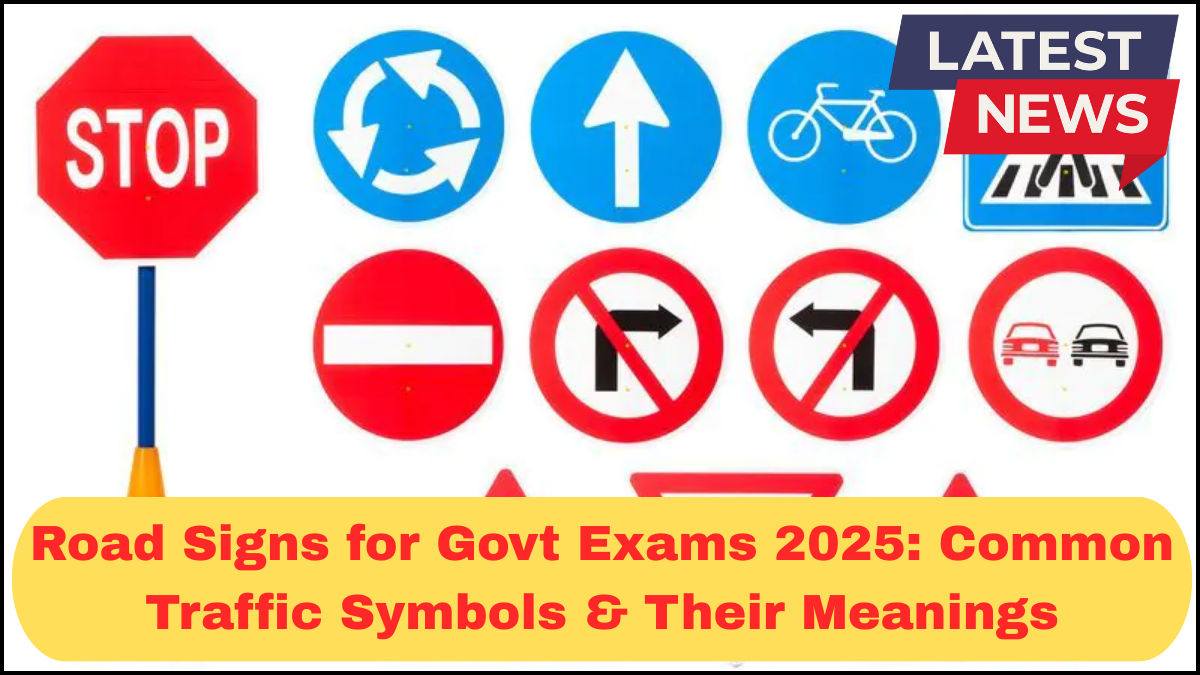If you’re preparing for Road Signs for Competitive Exams 2025, understanding traffic symbols isn’t optional—it’s essential. These symbols test your visual memory, comprehension, and your ability to make quick decisions under pressure. Whether it’s SSC, UPSC, RRB, or state-level exams, traffic signs often feature in general awareness or reasoning sections.
This guide breaks down the most frequently asked road signs and what they mean, helping you build a stronger foundation and score higher.

What Are Road Signs and Why Are They Important?
Road signs are standardized visual indicators used to regulate, warn, or guide traffic. They’re designed to be understood quickly and easily, regardless of the driver’s native language. From a competitive exam standpoint, they’re not just general knowledge—they reflect practical awareness of civic responsibility.
In Road Signs for Competitive Exams 2025, questions may test your ability to recognize signs, match them with their meanings, or determine correct driving behavior in a given scenario.
Categories of Traffic Symbols
Traffic signs are categorized for easy understanding. Here are the three main types you’ll see in exams:
1. Mandatory Signs
These signs give direct instructions. Ignoring them is illegal and can lead to penalties. They are typically circular with a red border.
Examples:
-
Stop Sign: Octagonal red sign with “STOP” written in white. It mandates complete cessation of movement.
-
No Entry: A red circle with a white horizontal line indicates vehicles are not allowed to enter.
-
Speed Limit: A circular sign with a number, like “50”, restricts the speed to 50 km/h.
Exam Tip: Mandatory signs are often the most featured in traffic symbol-related questions.
2. Cautionary or Warning Signs
These signs warn drivers of possible dangers or road conditions ahead. Usually triangular with a red border.
Examples:
-
School Ahead: Indicates a school zone; drivers should reduce speed and stay alert.
-
Slippery Road: Warns of roads where grip may be reduced due to rain or oil.
-
Curve Ahead: Informs drivers of sharp curves that require speed adjustment.
Real-World Insight: These signs are not just academic—they reflect real-life driving scenarios often referenced in traffic symbols frequently asked questions sections.
3. Informatory Signs
These guide the driver by providing helpful information. Typically rectangular and colored blue.
Examples:
-
Hospital: Shows the direction or proximity of a medical facility.
-
Petrol Pump: Indicates a nearby fuel station.
-
Parking Area: Shows designated parking spots.
Informatory signs are often asked in comprehension-based questions in Govt Exams 2025.
Important Road Signs to Memorize for Competitive Exams
To help you with quick revision, here’s a table of critical traffic signs:
| Symbol | Type | Meaning |
|---|---|---|
| 🛑 | Mandatory | Stop |
| ⛔ | Mandatory | No Entry |
| ⚠️👶 | Cautionary | School Ahead |
| 🅿️ | Informatory | Parking Area |
| 🛣️ | Informatory | Expressway |
| 🚗↩️ | Cautionary | Left/Right Turn Ahead |
| 🚦 | Cautionary | Traffic Signals Ahead |
| 🚫🚙 | Mandatory | No Motor Vehicles |
How to Remember Traffic Symbols Effectively
-
Use Visual Flashcards: Repetition with images helps commit signs to memory.
-
Practice Mock Tests: Many apps and websites simulate exam patterns with traffic symbol questions.
-
Group Learning: Discussing signs with peers often helps reinforce knowledge.
-
Link Symbols to Real-Life Scenarios: Connect each sign with situations you’ve seen on roads.
Common Mistakes to Avoid in the Exam
-
Confusing Cautionary and Mandatory Signs: Red circles indicate compulsion, while red triangles mean warning.
-
Misinterpreting Similar Icons: “No Parking” and “No Stopping” look similar but have different meanings.
-
Ignoring Informative Signs: These are increasingly included in Road Signs for Competitive Exams 2025, especially in reasoning-based questions.
FAQs: Traffic Symbols Frequently Asked Questions
Q1. Are traffic signs part of every government exam in 2025?
Yes. Exams like SSC CHSL, RRB NTPC, State Police, and UPSC often include questions related to road signs in the general awareness or reasoning section.
Q2. Which category of signs is most commonly asked?
Mandatory signs are the most frequently asked, especially “Stop”, “No Entry”, and “Speed Limit” signs.
Q3. What is the best way to prepare for traffic symbol questions?
Use flashcards, take regular quizzes, and refer to official road safety PDFs provided by the Ministry of Road Transport.
Q4. Can similar-looking signs appear with different meanings?
Yes. For example, “No Overtaking” and “No Parking” may appear similar at first glance but differ in icon details and meaning.
Q5. Where can I find reliable study material on road signs?
You can refer to the Indian Road Safety Rules handbook, NCERT general knowledge books, and online mock test platforms focused on Road Signs for Competitive Exams 2025.
click here to learn more